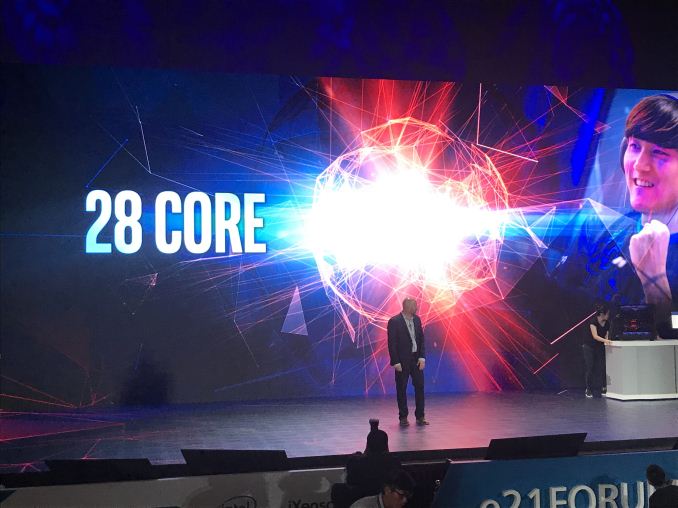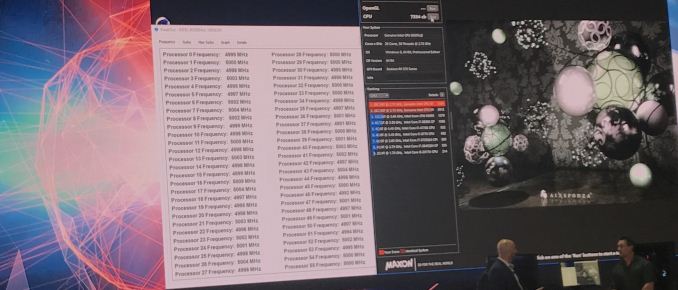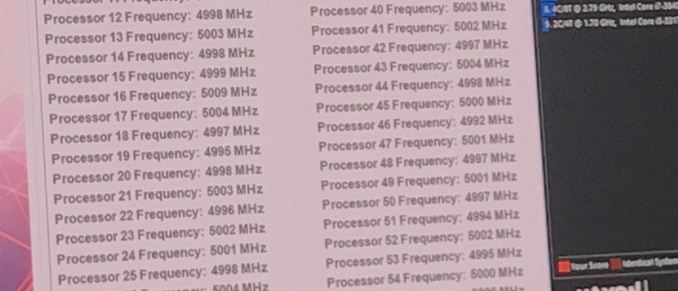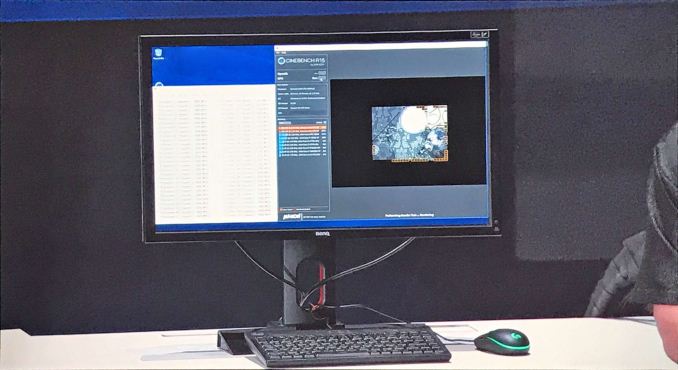Intel’s 28-Core 5 GHz CPU: Coming in Q4
by Ian Cutress on June 5, 2018 3:09 AM EST- Posted in
- CPUs
- Intel
- Trade Shows
- Computex 2018
- 28-core

Update 06/08: Intel has since backtracked on its initial statements, clarifying that while a 28-core part is coming in Q4 of this year, its stock frequency will not be 5GHz. Rather this was a (very poorly communicated) overclocking demo of the upcoming part. For more details, please see this article.
Alongside the launch of Intel’s first 5 GHz processor, the 6-core Core i7-8086K, Intel today also showcased a 28-core single socket machine also running at 5 GHz. The system on display scored 7334 in Cinebench R15, and Gregory Bryant (SVP and GM of Intel Client Computing Group) explicitly stated that it would be coming in Q4 this year.
No other details were provided, however for it to exist in a current platform, this new processor would likely be in LGA2066 (X299) or LGA3647 (the server socket). Intel technically already makes 28-core monolithic designs in the Intel Xeon Scalable Platform with the Xeon Platinum 8180, which is a $10k processor, which runs a lot slower than 5.0 GHz.
Personally, I feel this new processor is not a higher binned Platinum 8180. Going up from 2.8 GHz base / 3.5 GHz turbo to 5.0 GHz all-core frequency is a big step, assuming the 5.0 GHz value was not an overclock. I would fully expect that this is the point where Intel starts introducing EMIB to CPUs. (ed: FWIW, I disagree with Ian; my money is on a heavily binned 28-core XCC processor made on 14++. We've seen that Intel can do 5GHz on that process with the 8086K)
Last week I discussed the potential death of Intel’s low-end core design for high-end desktop, because it was being eclipsed by the mainstream parts. The only way Intel would be able to reuse the server versions of those low-core count designs would be to enable its embedded multi-die interconnect bridge (EMIB) technology to put two or more of the smaller dies on the same package. This would allow Intel do amortize costs in the same way AMD does by making use of higher yielding parts (as die size goes down, yield goes up).
Intel’s EMIB has a potentially high bi-directional bandwidth, so it would be interesting to see if Intel would bind two dies together and if there is any additional latency or bandwidth decrease with two dies together. With 28 cores, that would subdivide by two to 14-each, but not to four. So this processor is likely to be two 14-core dies using EMIB… which would actually be Intel’s HCC (high-core-count) processor design.
To add something extra to the mix, Intel might not be using EMIB at all. It could just as easily be the QPI interface on package, much how the company is using the Xeon + FPGA products announced recently.
So our primary questions to Intel would be:
- Monolithic or multi-die
- QPI or EMIB
- Socket
- Die size
- TDP / Power consumption at 5 GHz
TDP is a big part of the equation here. 28 cores at 5.0 GHz doesn’t come for free. The next questions are around price and launch date.
Additional:
There's the discussion about cutting into Intel's 1P market with such a product. But also, consider that at CES that Supermicro rated their X299 motherboards as supporting 300W processors, so it could easily correlate this processor to LGA2066 and a 300W TDP. That would be... fun... I guess?
| Want to keep up to date with all of our Computex 2018 Coverage? | ||||||
 Laptops |
 Hardware |
 Chips |
||||
| Follow AnandTech's breaking news here! | ||||||













87 Comments
View All Comments
HStewart - Tuesday, June 5, 2018 - link
WCCFTech is joke and full of AMD Bios people - if you don't believe it look at comment sections and especially the picture. Also they are showing a dual CPU motherboard and not a desktop processor.I believe that you are wrong about EMIB - it has a lot of potential - not only this XPS 15 2in1 that I am typing this on - but also with high end engineer chips like FPGA's where I believe the technology came from. The key is also that HDM2 memory can also be kept on same EMIB and it can used different technologies on the EMIB.
Ket_MANIAC - Tuesday, June 5, 2018 - link
It won't run at 5 GHz normally. This is on a server platform, the LGA 3647 and pictures have been taken to show it uses a compressor or some other kind of exotic cooling. Intel being their shady selves, just like ever.zodiacfml - Tuesday, June 5, 2018 - link
Hard to believe it unless they have gone all out, Indium solder and AIO cooling.Oberoth - Tuesday, June 5, 2018 - link
I find it virtually impossible to believe that Intel will be able to make a 28 core CPU run at 5GHz on all cores within 6 months, they can't even do that with 6 cores today. And if it was being cooled by liquid nitrogen this would be exceptionally misleading. I see only 4 explanations for this announcement:1) It is a misunderstanding or vapourware, maybe he meant by the end of the decade which I still wouldn't believe.
2) They use a totally different type of core which isn't very complex but can clock quite high, kind of like Larrabee.
3) The TDP is like 1000 Watts and you need specialist high flow water cooling system to run it which comes pre-bonded direct to the die.
4) Intel has been sandbagging us that 10nm wasn't working properly and it's actually a magical node they defies the known laws of thermodynamics.
My money is on this being vapourware and is just Intel trying to get people's attention in the hope if they are waiting for this to come out then they are not buying AMD CPUs.
HStewart - Tuesday, June 5, 2018 - link
Intel could have 10nm coming out - I am pretty sure that they are planning something big with 10nm - I don't believe this is vaporware, since it actually came from Intel demonstration. If it came from site like WCCFtech or such - or in comments sections, I could believe it is vaporware - but not from real company like Intel.HStewart - Tuesday, June 5, 2018 - link
This chip is real and states Q2 and not vaporwarehttps://ark.intel.com/products/148263/Intel-Core-i...
HStewart - Tuesday, June 5, 2018 - link
But this one is only 6 core - but mobile at 95watts.. same name … interesting.Valantar - Tuesday, June 5, 2018 - link
It was very obvious that this was an OC demo - it was housed in a case with some sort of sub-zero cooling, with insulated hoses coming out of the rear. Definitely not shipping st 5GHz all-core. Given the kind of power draw an 18-core i9 has at those frequencies, we're probably talking 7-800W CPU power alone.HStewart - Tuesday, June 5, 2018 - link
Just remember that Intel has been working with Dell to create high performance in extremely thin and low power laptop like XPS 15 2in1. Just imagine what they can do with desktop that is literary 10 times the size of this laptop or more.Valantar - Wednesday, June 6, 2018 - link
That doesn't add up. The key point here is thermal density, and while the die size of of a HCC Xeon is significantly bigger than, say, a 6-core CFL, the package size and thus the thermal interface isn't _that_ much bigger. All the while, the power draw and heat output is 3-4-5x. Also, remember that laptops use direct-die cooling, with thin heatspreaders and heat pipes or vapor chambers directly contacting the die. No IHS there, which makes cooling significantly easier.Then there's the concentration of hot spots. A 6-core CFL pulls around 160-200W at 5-5.1GHz. Subtracting 10W for the uncore, that's 25-31W per core. The cores are located within a few mm from each other. The 8700K has six of them, and requires a 360mm AIO or similar to stay reasonably cool simply due to the immense concentration of heat. For comparison, a 250W GPU stays reasonably cool with a 120mm AIO due to direct die contact and fewer hot spots/more spread-out heat generation. The issue with CPUs isn't the size of the AIO, but rather getting the heat from the cores to the water (and then the radiator) efficiently. Given that the cores on HCC dice are still grouped very close, the bigger IHS doesn't really help much, so you're effectively asking to dissipate 4-5x the heat through 2-3x the area. In other words: cooling this is even more difficult.
Conclusion: you'll need exotic cooling for this, simply to have sufficient thermal transfer in a small enough area to keep from thermal throttling.